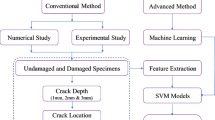Abstract
This paper presents a modal parameter estimation of a cantilevered steel beam using low-cost wireless accelerometers for structural health monitoring. To demonstrate the feasibility of using wireless accelerometers, the frequency response functions (FRFs) for the beam are measured. A curve-fitting algorithm is then applied to extract the modal parameters, such as natural frequencies, damping ratios, and mode shapes. These dynamic characteristics of the cantilever beam are acquired and interpreted through the FRFs by the commercial analyzing software. Experimental results show that wireless accelerometers can successfully determine the dynamic properties of the cantilever beam. This paper provides the analytical basis of applying wireless accelerometers to the experimental modal analysis and supports for the feasibility of cantilever beam modal testing using low-cost wireless accelerometers.










Similar content being viewed by others
References
Wang Y, Lynch JP, Law KH (2007) A wireless structural health monitoring system with multithreaded sensing devices: design and validation. Struct Infrastruct Eng 3(2):103–120
Bocca M, Eriksson LM, Mahmood A, Jantti R (2011) A synchronized wireless sensor network for experimental modal analysis in structural health monitoring. Comput-Aided Civ Infrastruct Eng 26:483–499
Schwarz BJ, Richardson MH (1999) Experimental modal analysis. CSI Reliability Week, Orlando
Avitabile P (2001) Experimental modal analysis. Sound Vib 35(1):20–31
Al-Khazali HA, Askari M (2011) Calculations of frequency response functions using computer smart office software and Nyquist plot under gyroscopic effect rotation. Int’l J Comput Sci Inf Technol Secur 1(2):90–97
Wang BT, Wang CC (1997) Feasibility analysis of using piezoceramic transducers for cantilever beam modal testing. Smart Materials and Structures 6(1):106–116
Leonard M (2001) Fundamentals of vibrations. Mcgraw-Hill, New York
Giordano J, Burtschell Y (2012) Confrontation of genetic algorithm optimization process with a new reference case: analytical study with experimental validation of the deflection of a cantilever beam. Int’l J Adv Sci Technol 49:105–118
Humar J (2002) Dynamics of structures, 2nd edn. Taylor & Francis, London
Schwarz BJ, Richardson MH (1999) Experimental modal analysis. CSI Reliab Week 35(1):1–12
PCB Piezotronics, http://www.pcb.com/imisensors/IMISensors_Industrial_Accelerometers
Microstrain sensors, http://www.microstrain.com/wireless/sensors
Libelium Waspmote, http://www.libelium.com/products/waspmote/
Smart Office Analyzer, http://www.mpihome.com/en
Chougule P, Kirkegaard PH, Nielsen SRK (2010) Low cost wireless sensor network for structural health monitoring. Paper presented at Scandinavian vibration forum: skandanaviska vibrationsforenigen (SVIB), Linkoping, Sweden, pp 1–4
Waspmote Datasheet, http://www.libelium.com/products/waspmote
Lim Y, Park J (2015) Networking strategies for structural health monitoring in wireless sensor networks. Int’l J Energy Inf Commun 6(3):11–18
Acknowledgments
This research was supported by Basic Science Research Program through the National Research Foundation of Korea(NRF) funded by the Ministry of Education (No. 2014-0024242).
Author information
Authors and Affiliations
Corresponding author
Rights and permissions
About this article
Cite this article
Sohn, S. Feasibility study on the use of wireless accelerometers in the experimental modal testing. J Supercomput 72, 2848–2859 (2016). https://doi.org/10.1007/s11227-016-1628-8
Published:
Issue Date:
DOI: https://doi.org/10.1007/s11227-016-1628-8




